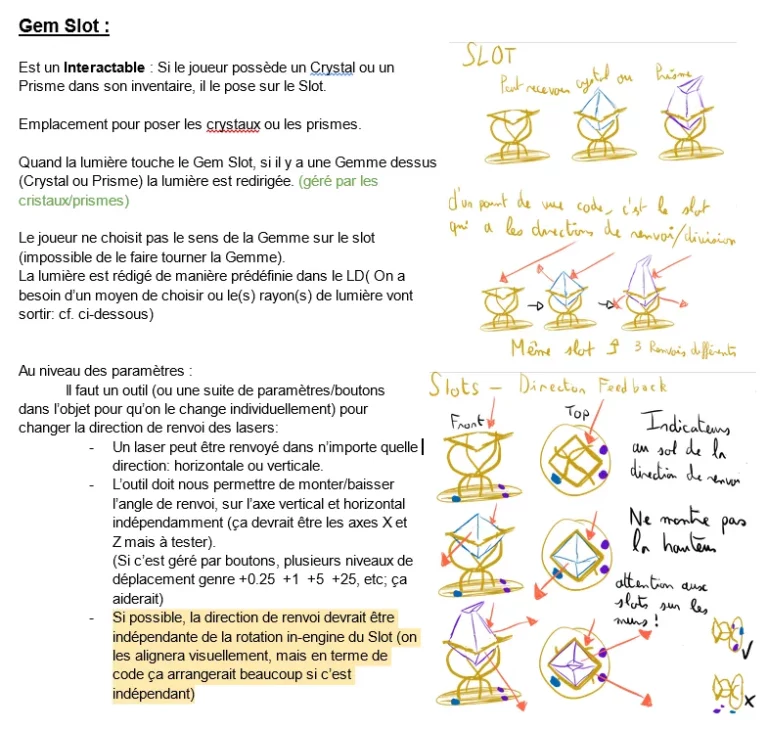
Deep Dive
The DIIG is a puzzle game where the goal is to find the mysterious Pyramid, treasure of Cocytus. You can pick up and place light-bending gems to refract light beams into receptors; opening up the way, there are also special gems that split the light in two!
Along the way, you’ll find stone tablets containing hints on what to do, for example giving out the sequence of statue rotations to perform to unlock another light receptor.
It is a school project aiming to “““remake””” The Dig (1995), a classic 2D Point & Click game, all while keeping the same characters, environments (but in 3D), and one mechanic of our choice.
This was all done in under 3 weeks, and was our first Unreal Engine project.
Designing as a Team
The goal for this game was to inherit a game mechanic from the original The Dig, and we ended up with three main candidates:
– The Planetarium, capable of manipulating the moons to open passages
– The “Pick Up & Inspect” action available on objects like the rods to get hints
– The Shovel, mighty tool able to do basically everything important in the original game
The Inspect action seemed the most flexible one, so we decided to go for that.
We initially planned a small tutorial room, then two big rooms with chaining puzzles, and then a final “cinematic” room with a pretty scenery but no gameplay; for a total of two different environments…
Well obviously doing 2 different environments in 3 weeks was impossible, so we changed plans and kept only the underwater dome.
One other example of plan changes is in the Gems. They initially were exactly the same model, just color swapped pink and blue.
But this made it impossible to differentiate with certain types of colorblindness, especially since the colors had the same luminosity.
We countered this by making two different models, and having better contrast between the two types.

Excerpt of our Design-Programmer explanation document. I’m not gonna translate from French, but it’s the description of how Gem Slots work in detail with drawings.
To make communication between our Design and Programming poles easier, especially in such short notice, we made a big document explaining every mechanic and interactable object in details, with specificities and variables that need to be exposed for the LD phases. We also had a specific document dedicated for reporting bugs (with pictures).
This was especially important since 4 people out of 15 were in remote for the majority of the production.
Using the fact that we were 4 Designers in our group, we took some time early on to prepare a Signs & Feedbacks document for every mechanic and interactable objects.
We didn’t, however, think about sound feedbacks… only visual ones.
Lesson learned for next times!
Puzzling Harder
For the puzzles, the main mechanic is “lasers being redirected and duplicated when going through gems”. You can pick gems up and place them onto slots to change the laser’s directions. Blue gems simply redirect the laser, and Pink gems split it in two before redirecting.
Our entire game ended up being themed on Circularity.
Both in the environment being made up of multiple circles; but also in the Level Design: Backtracking & Reusability of the same gems over and over made the game more coherent and less feeling like “separate chambers”.
Plus, it also let us get more out of our singular environment!
To help with the Level Design, our programmers made a small Unreal Tool to quickly (and visually) change the output angle of each laser, horizontally and vertically.
The laser gem tool in action
Like many other projects I worked on, I’ve composed the music for this game. At first, I tried to bring in elements from the original OST, mainly “Ghosts”, “Mission to the Asteroid” and “Underwater Cavern”. However, with the piece needing to be done in a few days, at home; I came back to my roots and used my “signature” Glass Piano. I still tried to compose orchestral-sounding parts which were challenging in a good way.
“Boston Deep Sea Walk”: The main (and only) theme of THE DIIG. Almost two full minutes of the loop are composed of rain and white noise without any melody to space out and calm down the whole piece.